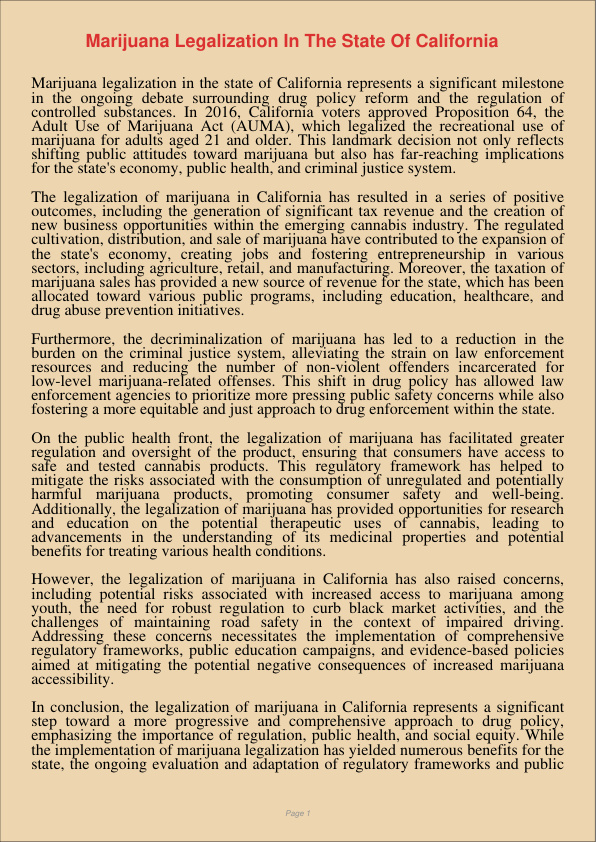Marijuana Legalization In The State Of California
Jan 9, 2024
marijuana legalization
state
Nursing
English

Marijuana legalization in the state of California represents a significant milestone in the ongoing debate surrounding drug policy reform and the regulation of controlled substances. In 2016, California voters approved Proposition 64, the Adult Use of Marijuana Act (AUMA), which legalized the recreational use of marijuana for adults aged 21 and older. This landmark decision not only reflects shifting public attitudes toward marijuana but also has far-reaching implications for the state’s economy, public health, and criminal justice system.
The legalization of marijuana in California has resulted in a series of positive outcomes, including the generation of significant tax revenue and the creation of new business opportunities within the emerging cannabis industry. The regulated cultivation, distribution, and sale of marijuana have contributed to the expansion of the state’s economy, creating jobs and fostering entrepreneurship in various sectors, including agriculture, retail, and manufacturing. Moreover, the taxation of marijuana sales has provided a new source of revenue for the state, which has been allocated toward various public programs, including education, healthcare, and drug abuse prevention initiatives.
Furthermore, the decriminalization of marijuana has led to a reduction in the burden on the criminal justice system, alleviating the strain on law enforcement resources and reducing the number of non-violent offenders incarcerated for low-level marijuana-related offenses. This shift in drug policy has allowed law enforcement agencies to prioritize more pressing public safety concerns while also fostering a more equitable and just approach to drug enforcement within the state.
On the public health front, the legalization of marijuana has facilitated greater regulation and oversight of the product, ensuring that consumers have access to safe and tested cannabis products. This regulatory framework has helped to mitigate the risks associated with the consumption of unregulated and potentially harmful marijuana products, promoting consumer safety and well-being. Additionally, the legalization of marijuana has provided opportunities for research and education on the potential therapeutic uses of cannabis, leading to advancements in the understanding of its medicinal properties and potential benefits for treating various health conditions.
However, the legalization of marijuana in California has also raised concerns, including potential risks associated with increased access to marijuana among youth, the need for robust regulation to curb black market activities, and the challenges of maintaining road safety in the context of impaired driving. Addressing these concerns necessitates the implementation of comprehensive regulatory frameworks, public education campaigns, and evidence-based policies aimed at mitigating the potential negative consequences of increased marijuana accessibility.
In conclusion, the legalization of marijuana in California represents a significant step toward a more progressive and comprehensive approach to drug policy, emphasizing the importance of regulation, public health, and social equity. While the implementation of marijuana legalization has yielded numerous benefits for the state, the ongoing evaluation and adaptation of regulatory frameworks and public health initiatives remain essential in maximizing the positive impacts and minimizing the potential risks associated with the recreational use of marijuana.